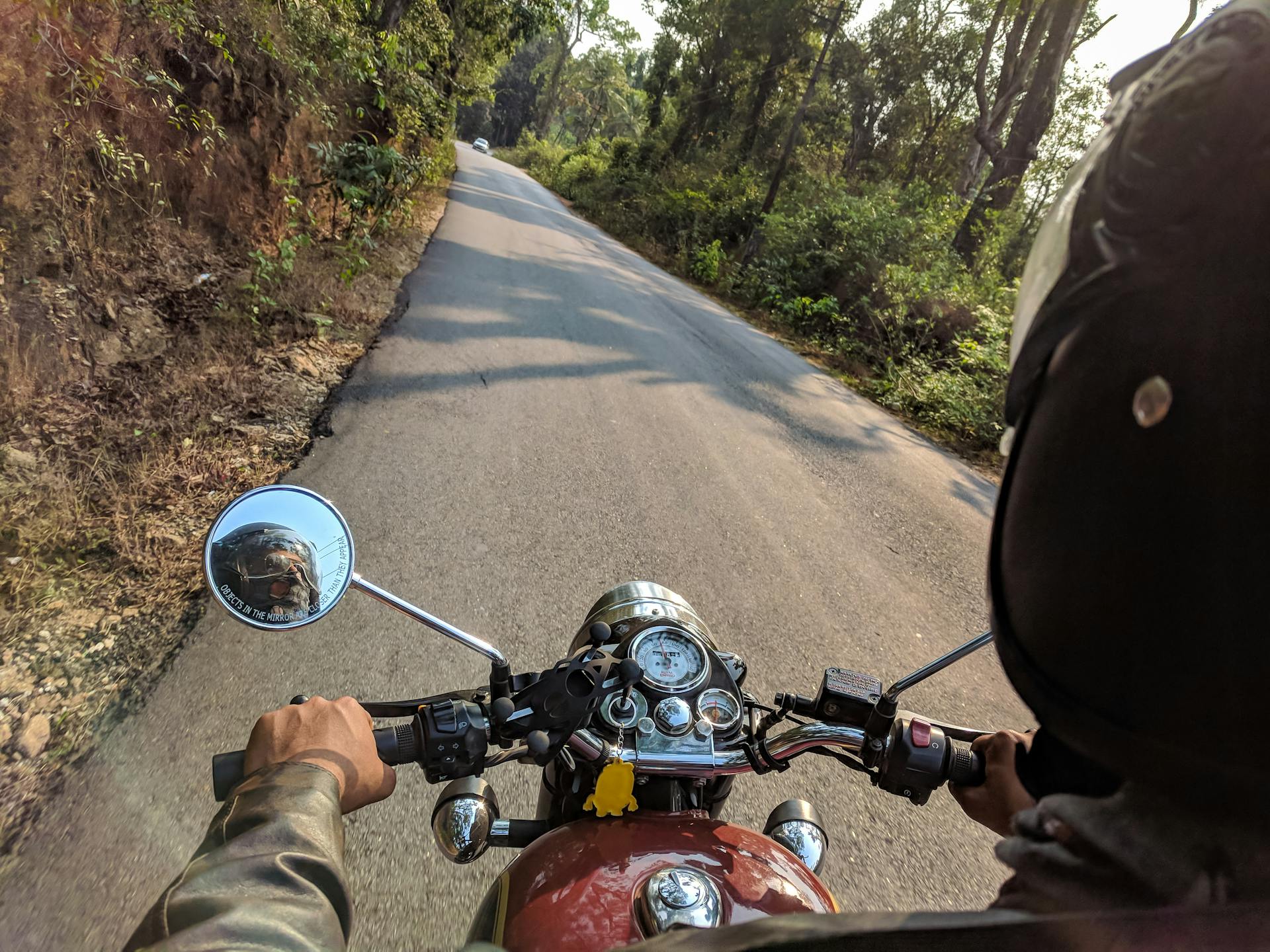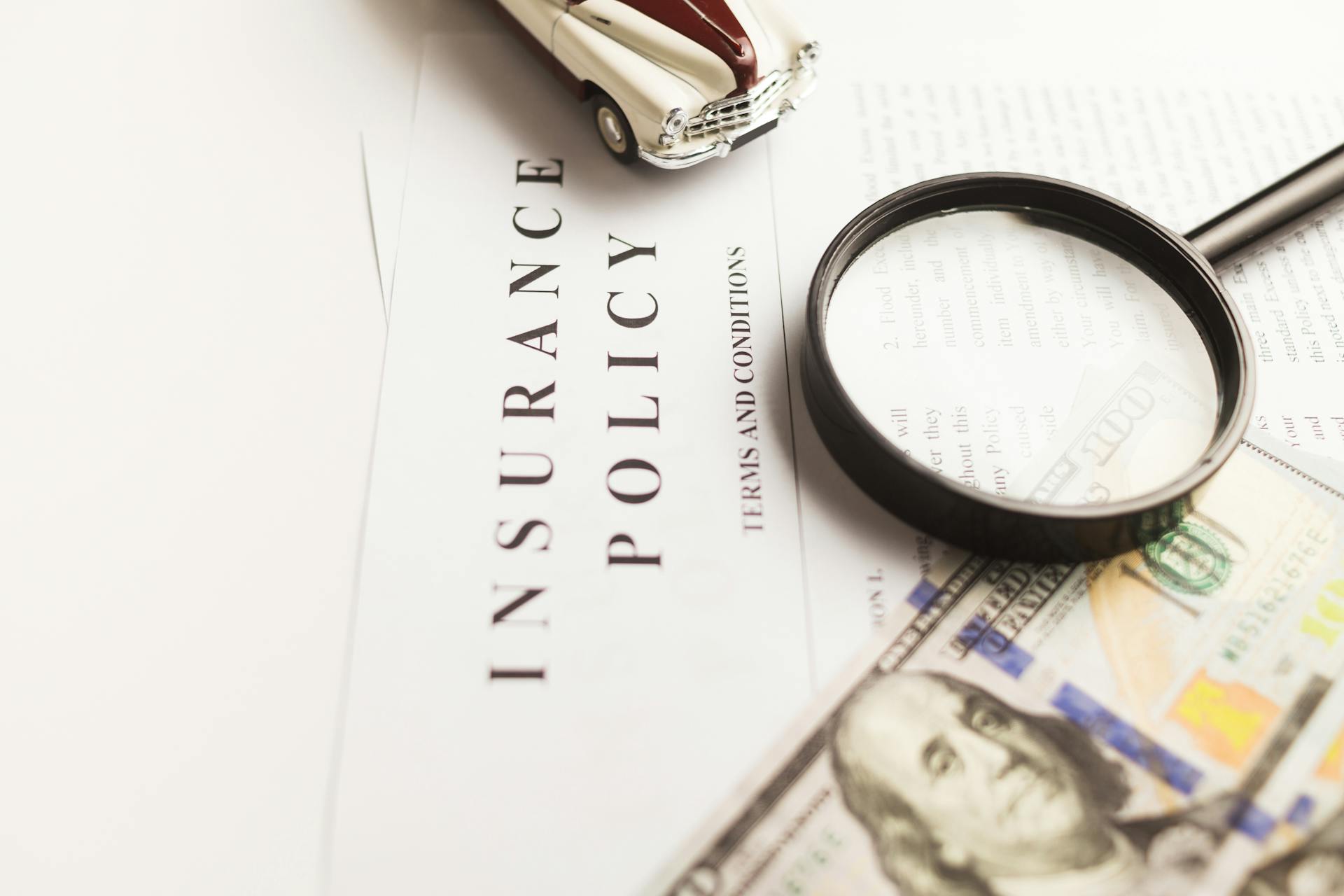
In New York State, motorcycle insurance is mandatory for riders. You'll need to carry a minimum amount of liability coverage to register your bike.
The state requires a minimum of $25,000 in bodily injury liability coverage per person, $50,000 per accident, and $10,000 for property damage. This is the minimum you'll need to be road-ready.
New York State also offers various options for motorcycle insurance riders, including collision and comprehensive coverage. This can help protect you from financial losses if your bike is damaged or stolen.
On a similar theme: Do I Need Motorcycle Insurance
Rider Requirements
To ride a motorcycle in New York, you must wear a helmet regardless of age or riding experience. Your helmet can have a speaker, but it must be in only one ear.
Helmets are not the only safety gear required - you must also wear eye protection that meets American National Standards Institute (ANSI) standards. This can be in the form of approved goggles or a helmet with an attached face shield.
To ensure your safety and the safety of others, your motorcycle must have certain features. These include brakes on both wheels for motorcycles manufactured in or after 1971, at least one red reflector facing rearward, and a working speedometer for bikes manufactured in or after 1980.
Here are the motorcycle safety requirements in New York:
State Requirements
To ride a motorcycle in New York, you'll need to familiarize yourself with the state's requirements. You must register your motorcycle and show proof of insurance.
The minimum insurance coverages required to ride legally in New York are: $25,000 for bodily injury liability per person and $50,000 per accident, $25,000 for guest passenger liability per person and $50,000 per accident, $10,000 for property damage liability, $25,000 for uninsured motorist (UM) bodily injury per person and $50,000 per accident, and $50,000 for personal injury protection (PIP).
You'll also need to purchase your motorcycle insurance from a provider certified by the New York DMV and licensed by the New York State Department of Financial Services.
If this caught your attention, see: When Is Professional Liability Insurance Required
To be street legal in New York, your motorcycle must have certain equipment, including eye protection, a handlebar height with handgrips at or below shoulder height, a helmet, mirrors, turn signals (if manufactured after 1-1-1985), a passenger seat and footrest (if carrying a passenger), a headlight, and a muffler that meets specific noise limits.
Here are the minimum liability coverage limits in New York for motorcycle insurance:
Recommended for Riders
If you're a daily rider in New York, consider Markel for its affordable rates, averaging $20 per month for a full coverage policy, which is 25% cheaper than average in the state.
Markel also offers rental car reimbursement, a crucial coverage for riders who rely on their motorcycles as their only vehicle. This coverage will pay for a rental car while your bike is in the shop after an accident.
However, be aware that Markel gets four times more complaints than other similar-sized insurance companies, according to the NAIC, which may lead to longer wait times to get back on the road after an accident.
Additional reading: Car Insurance Cancellation Laws California
To ensure you're getting the best coverage, consider the following options:
Collision coverage
Comprehensive coverage
Uninsured/under-insured motorist coverage
These types of coverage can protect you in various scenarios, such as collisions with other vehicles or stationary objects, theft, vandalism, or accidents involving uninsured or under-insured drivers.
Liability and Protection
You'll want to ensure you have adequate liability coverage to protect yourself and your passengers in case of an accident. In New York, the minimum liability coverage required is $25,000 per person and $50,000 per accident, with a minimum of $10,000 for property damage.
Liability coverage helps pay for the injured person's medical bills and lost income, as well as property damage to another's vehicle or property. However, it's essential to note that it does not cover your injuries or damage to your motorcycle.
If you cause an accident and someone is injured, liability coverage can help limit your out-of-pocket costs. However, if you only have the minimum insurance coverage, you cannot purchase more uninsured or underinsured coverage, which can leave you vulnerable in case of a serious accident.
Here are some key facts to keep in mind:
- Required: New York requires minimum liability coverage of $25,000 per person and $50,000 per accident, with a minimum of $10,000 for property damage.
- Should Have: Motorcycle operators should consider substantially increasing their liability coverage over the basic mandatory coverage.
Collision
Collision coverage is a type of insurance that helps pay for damage to your motorcycle after an accident. This can include damage from a collision with another vehicle or a stationary object, or even if your motorcycle tips over and is damaged.
You'll choose your deductible, which is the amount of money you'll pay out-of-pocket before the insurance company pays for any damage to your motorcycle. This is an important decision, as it can affect how much you'll pay for coverage.
Collision insurance typically only covers the book value of your motorcycle before the loss occurred. This means that if your motorcycle is worth more than the book value, you won't be able to get the full amount of the damage covered.
If you financed your motorcycle, the finance company will likely require you to carry collision coverage. This is because they want to protect their investment in your motorcycle.
A unique perspective: Mutual Life Insurance Company of New York
If you don't have collision coverage and you can prove that someone else is negligent for causing the damage to your motorcycle, you can file a claim against that person and/or their insurance company.
Here are some key things to consider about collision coverage:
- Required: New York does not require collision coverage.
- Should Have: Unless you can afford to pay out-of-pocket for the damages to your motorcycle, you should consider collision coverage.
- Important Consideration: If you can afford out-of-pocket repairs after an accident, then collision coverage is not necessary.
Ultimately, whether or not you choose to carry collision coverage depends on your individual circumstances and financial situation.
Liability
Liability is a crucial aspect of motorcycle insurance, and it's essential to understand what it covers and what it doesn't.
Liability coverage helps pay for the injured person's medical bills and lost income if you cause an accident.
If you cause an accident and there is damage to another person's vehicle or property, property damage liability helps pay for those damages.
Bodily injury and property damage liability coverage do not cover your injuries or damage to your motorcycle.
New York requires minimum liability coverage of $25,000 per person and $50,000 per accident, increasing to $50,000 per person and $100,000 per accident if you kill someone.
Suggestion: Property and Casualty Insurance Guaranty Funds
Here are the specific requirements for liability coverage in New York:
- $25,000 per person for bodily injury
- $50,000 per accident for bodily injury
- $10,000 for property damage
It's worth noting that your passenger's medical bills will need to be paid by their personal health insurance policy if you don't have a Guest Passenger Liability rider.
If you seriously injure or kill someone and their injuries exceed your liability coverage, your personal income, home, and assets are at stake.
Uninsured/Underinsured Motorist Bodily Injury Liability
In New York, purchasing supplementary uninsured and underinsured motorist bodily injury liability coverage can help limit your out-of-pocket costs in case the other motorist doesn't have enough coverage to pay for your injuries or vehicle repairs.
This type of coverage is designed to protect you and your passengers for bodily injuries if your motorcycle is struck by an uninsured or underinsured driver. One in eight drivers in the United States is uninsured, so it's essential to have this coverage.
Uninsured motorist coverage (UM) includes medical expenses, lost wages, and funeral expenses. It can also include property damage coverage, which pays for the damage to your motorcycle if the other driver is uninsured.
Readers also liked: Does Life Insurance Cover Burial Expenses
Here are the key takeaways about uninsured and underinsured motorist bodily injury liability coverage:
- New York requires minimum uninsured motorist coverage.
- Underinsured motorist coverage is not required in New York, but it's highly recommended.
- This coverage is crucial for motorcyclists because it pays for injuries or damages when the other driver is uninsured or underinsured.
Without underinsured motorist coverage, you may be left to cover any medical and lost wage expenses above $25,000. This is why it's essential to consider purchasing underinsured motorist coverage, especially if you're a motorcyclist.
Frequently Asked Questions
What insurance company is best for motorcycles?
For motorcycle insurance, consider top-rated options like Dairyland, Allstate, and Progressive, each offering unique coverage and benefits. Research each company to find the best fit for your needs.
Sources
- https://www.dairylandinsurance.com/motorcycle/new-york-insurance-requirements
- https://mclclaw.com/practices/personal-injury/motorcycle-accidents/essential-legal-guide-to-motorcycle-insurance-in-new-york/
- https://www.valuepenguin.com/best-cheap-motorcycle-insurance-new-york
- https://www.bikebound.com/motorcycle-insurance/states/new-york/
- https://www.wny-lawyers.com/2023/07/how-to-choose-the-right-motorcycle-insurance-in-new-york/
Featured Images: pexels.com


